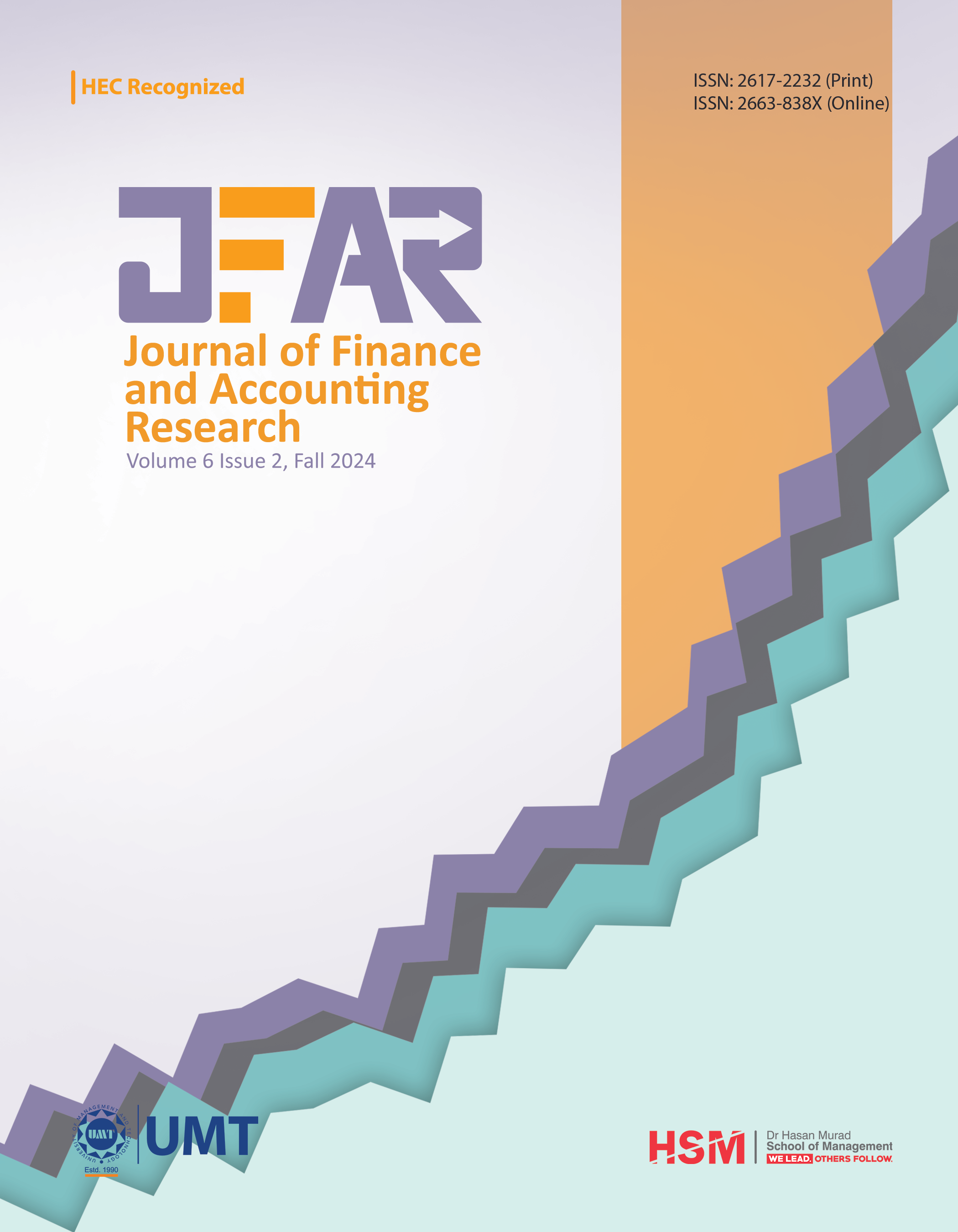Behavioral Finance: Impact of Psychology, Market Forces, and Social Influence on Portfolio Returns
Abstract
Traditional finance assumes rational decision-making in the stock market. This is challenged by behavioural finance, which postulates that cognitive biases, market dynamics, and social persuasion influence investors. Hence, this study on 300 retail investors at the Pakistan Stock Exchange (PSX) explores the impact of these factors on portfolio returns. The results indicate that cognitive biases, such as anchoring and overconfidence, lead to suboptimal decisions. Conversely, investors attuned to market dynamics make more successful choices, while resistance to social persuasion enhances decision quality. The findings highlight the need for investor awareness and mitigation of cognitive biases. Fund managers should incorporate these insights into strategies and regulators should educate investors on biases, while implementing policies against market manipulation.
Downloads
References
Abdolazimi, O., Shishebori, D., Goodarzian, F., Ghasemi, P., & Appolloni, A. (2021). Designing a new mathematical model based on ABC analysis for inventory control problem: A real case study. RAIRO-operations Research, 55(4), 2309–2335. https://doi.org/10.1051/ro/2021104
Ady, S. U., Tyas, A. M., Farida, I., & Gunawan, A. W. (2020). Immediate and expected emotions toward stock returns through overconfidence and cognitive dissonance: The Study Of Indonesian investor behavior. PalArch's Journal of Archaeology of Egypt/Egyptology, 17(3), 1140–1165.
Ahmadi, S. A., & Peivandizadeh, A. (2022). Sustainable portfolio optimization model using promethee ranking: A case study of palm oil buyer companies. Discrete Dynamics in Nature and Society, 2022, Article e8935213. https://doi.org/10.1155/2022/8935213
Akçay, E., & Hirshleifer, D. (2021). Social finance as cultural evolution, transmission bias, and market dynamics. Proceedings of the National Academy of Sciences, 118(26), Article e2015568118. https://doi.org/10.1073/pnas.2015568118
Alkaraan, F., Albahloul, M., & Hussainey, K. (2023). Carillion's strategic choices and the boardroom's strategies of persuasive appeals: Ethos, logos and pathos. Journal of Applied Accounting Research, 24(4), 726–744. https://doi.org/10.1108/JAAR-06-2022-0134
Almansour, B. Y., Elkrghli, S., & Almansour, A. Y. (2023). Behavioral finance factors and investment decisions: A mediating role of risk perception. Cogent Economics & Finance, 11(2), Article e2239032. https://doi.org/10.1080/23322039.2023.2239032
Asim, M., Khan, M. Y., & Shafi, K. (2024). Investigation of herding behavior using machine learning models. Review of Behavioral Finance, 16(3), 424–438. https://doi.org/10.1108/RBF-05-2023-0121
Au, S.-Y., Dong, M., & Zhou, X. (2024). Does social interaction spread fear among institutional investors? Evidence from coronavirus disease 2019. Management Science, 70(4), 2406–2426. https://doi.org/10.1287/mnsc.2023.4814
Badhani, P. (2024). Behavioral economics in policy making. Indian Insituite of Ahmadabad. https://www.iima.ac.in/sites/default/files/2024-04/MCFME_RPIFME_1_27.03.2024.pdf
Baker, H. K., & Nofsinger, J. R. (2010). Behavioral finance: An overview. In H. K. Baker & J. R. Nofsinger (Eds.), Behavioral finance: Investors, corporations, and markets (pp. 1–21). John Wiley & Sons.
Barber, B. M., & Odean, T. (2000). Trading is hazardous to your wealth: The common stock investment performance of individual investors. The Journal of Finance, 55(2), 773–806. https://doi.org/10.1111/0022-1082.00226
Barberis, N. C., & Jin, L. J. (2023). Model-free and model-based learning as joint drivers of investor behavior (Working Paper No. 31081). National Beraeu of Economic Research. https://www.nber.org/papers/w31081
Bashir, T., Azam, N., Butt, A. A., Javed, A., & Tanvir, A. (2013). Are behavioral biases influenced by demographic characteristics & personality traits? Evidence from Pakistan. European Scientific Journal, 9(29), 277–293.
Bhanu, B. K. (2023). Behavioral finance and stock market anomalies: Exploring psychological factors influencing investment decisions. In N. Joshi, D. Sharma, R. P. Mahurkar, Dr. K. Shailashree, R. L. Kumari, T. Ilakkiya, N. Oswal, & P. K. Ingale (Eds.), Advancements in commerce, economics & management: A research compilation (pp. 23–32). Redshine Publication.
Broietti, C., Rover, S., & Azevedo, G. M. d. C. (2022). Investor behaviour in an environment of uncertainty: the impact of persuasion on investor decisions. International Journal of Applied Decision Sciences, 15(6), 663–680. https://doi.org/10.1504/IJADS.2022.126099
De Bondt, W., Mayoral, R. M., & Vallelado, E. (2013). Behavioral decision-making in finance: An overview and assessment of selected research. Spanish Journal of Finance and Accounting/Revista Española de Financiación y Contabilidad, 42(157), 99–118. https://doi.org/10.1080/02102412.2013.10779742
Ghosh, S., & Aithal, P. (2022). Behaviour of investment returns in the disinvestment environment: The case of power industry in Indian CPSEs. International Journal of Technology, Innovation and Management, 2(2), 65–79. https://doi.org/10.54489/ijtim.v2i2.95
Gong, X., Min, L., & Yu, C. (2022). Multi-period portfolio selection under the coherent fuzzy environment with dynamic risk-tolerance and expected-return levels. Applied Soft Computing, 114, Article e108104. https://doi.org/10.1016/j.asoc.2021.108104
Gunjan, A., & Bhattacharyya, S. (2023). A brief review of portfolio optimization techniques. Artificial Intelligence Review, 56(5), 3847–3886. https://doi.org/10.1007/s10462-022-10273-7
Gupta, N., Park, H., & Phaal, R. (2022). The portfolio planning, implementing, and governing process: An inductive approach. Technological Forecasting and Social Change, 180, Article e121652. https://doi.org/10.1016/j.techfore.2022.121652
Gupta, S., & Shrivastava, M. (2023). Behavioral finance: A critical literature review using Pareto analysis. Thailand and the World Economy, 41(2), 156–183.
Hair, J. F., Risher, J. J., Sarstedt, M., & Ringle, C. M. (2019). When to use and how to report the results of PLS-SEM. European Business Review, 31(1), 2–24. https://doi.org/10.1108/EBR-11-2018-0203
Hoffmann, C. P. (2023). Investor relations as strategic communication: Insights from evolutionary psychology. International Journal of Strategic Communication, 17(3), 213–227. https://doi.org/10.1080/1553118X.2023.2230575
Jia, W., Redigolo, G., Shu, S., & Zhao, J. (2020). Can social media distort price discovery? Evidence from merger rumors. Journal of Accounting and Economics, 70(1), Article e101334. https://doi.org/10.1016/j.jacceco.2020.101334
Jing, D., Imeni, M., Edalatpanah, S. A., Alburaikan, A., & Khalifa, H. A. E.-W. (2023). Optimal selection of stock portfolios using multi-criteria decision-making methods. Mathematics, 11(2), Article e415. https://doi.org/10.3390/math11020415
Kumar, S., Guha, S., & Ali, S. (2022). Applying behavioural finance approach to investment decisions: determinants of investment. In R. N. Subudhi, S. Mishra, A. Saleh, & D. Khezrimotlagh (Eds.), Future of Work and Business in Covid-19 Era: Proceedings of IMC-2021 (pp. 57–71). Springer.
Majewski, S., & Majewska, A. (2022). Behavioral portfolio as a tool supporting investment decisions. Procedia Computer Science, 207, 1713–1722. https://doi.org/10.1016/j.procs.2022.09.229
Metawea, M., Metawa, S., & Metawa, N. (2022). Predicting stock return risk and volatility using neural network. In N. Metawa, M. K. Hassan, & S. Metawa (Eds.), Artificial Intelligence and Big Data for Financial Risk Management: Intelligent Applications (pp. 67–82). Routledge.
Mitchell, M., & Pulvino, T. (2012). Arbitrage crashes and the speed of capital. Journal of Financial Economics, 104(3), 469–490. https://doi.org/10.1016/j.jfineco.2011.09.002
Narang, M., Joshi, M. C., Bisht, K., & Pal, A. (2022). Stock portfolio selection using a new decision-making approach based on the integration of fuzzy CoCoSo with Heronian mean operator. Decision Making: Applications in Management and Engineering, 5(1), 90–112. https://doi.org/10.31181/dmame0310022022n
Qadri, S. U., & Shabbir, M. (2014). An empirical study of overconfidence and illusion of control biases, Impact on investor’s decision making: An evidence from ISE. European Journal of Business and Management, 6(14), 38–44.
Qie, X., Wu, J., Li, Y., & Sun, Y. (2022). A stage model for agent-based emotional persuasion with an adaptive target: From a social exchange perspective. Information Sciences, 610, 90–113. https://doi.org/10.1016/j.ins.2022.07.147
Rasoolimanesh, S. M., Seyfi, S., Rather, R. A., & Hall, C. M. (2022). Investigating the mediating role of visitor satisfaction in the relationship between memorable tourism experiences and behavioral intentions in heritage tourism context. Tourism Review, 77(2), 687–709. https://doi.org/10.1108/TR-02-2021-0086
Shafique, M. R., Sohail, A., Nisar, S., & Munir, M. (2023). Examining financial decision-making of retail investors in Pakistan Stock Exchange (PSX): Moderating role of financial literacy. Journal of Applied Research and Multidisciplinary Studies, 4(1), 2–22. https://doi.org/10.32350/10.32350/JARMs/vol.41.01
Shafique, U., Rashid, U., Awan, F. G., Anwaar, H., & Nzanywayingoma, F. (2023). Diversification of energy resources for electricity generation in Pakistan via portfolio optimization. IEEE Access, 11, 126724–126732. https://doi.org/10.1109/ACCESS.2023.3328327
Shaik, M. B., Kethan, M., Jaggaiah, T., & Khizerulla, M. (2022). Financial literacy and investment behaviour of IT professional in India. East Asian Journal of Multidisciplinary Research, 1(5), 777–788. https://doi.org/10.55927/eajmr.v1i5.514
Shirazi, M., & Fuinhas, J. A. (2023). Portfolio decisions of primary energy sources and economic complexity: The world's large energy user evidence. Renewable Energy, 202, 347–361. https://doi.org/10.1016/j.renene.2022.11.050
Sinha, A., Sharif, A., Adhikari, A., & Sharma, A. (2022). Dependence structure between Indian financial market and energy commodities: A cross-quantilogram based evidence. Annals of Operations Research, 313(1), 257–287. https://doi.org/10.1007/s10479-021-04511-4
Solares, E., De-León-Gómez, V., Salas, F. G., & Díaz, R. (2022). A comprehensive decision support system for stock investment decisions. Expert Systems with Applications, 210, Article e118485. https://doi.org/10.1016/j.eswa.2022.118485
Spelta, A., Pecora, N., & Pagnottoni, P. (2022). Chaos based portfolio selection: A nonlinear dynamics approach. Expert Systems with Applications, 188, Article e116055. https://doi.org/10.1016/j.eswa.2021.116055
Subash, R. (2012). Role of behavioral finance in portfolio investment decisions: Evidence from India [Master thesis, Univerzita Karlova]. Charles Digital Repository. https://dspace.cuni.cz/handle/20.500.11956/43150
Subrahmanyam, A. (2008). Behavioural finance: A review and synthesis. European Financial Management, 14(1), 12–29. https://doi.org/10.1111/j.1468-036X.2007.00415.x
Velte, P. (2023). Sustainable institutional investors, corporate sustainability performance, and corporate tax avoidance: Empirical evidence for the European capital market. Corporate Social Responsibility and Environmental Management, 30(5), 2406–2418. https://doi.org/10.1002/csr.2492
Wei, J., Liu, X., & Fan, W. (2022). Dynamic sparse portfolio rebalancing model: A perspective of investors’ behavior-related decisions. Knowledge-Based Systems, 251, Article e109224. https://doi.org/10.1016/j.knosys.2022.109224
Wu, C. C., Yan, Y., Yuan, T., Huang, C. C., & Tsai, Y. J. (2022). A study of network negative news based on behavioral finance analysis of abnormal fluctuation of stock price. Discrete Dynamics in Nature and Society, 2022, Article e7952532. https://doi.org/10.1155/2022/7952532
Yuan, Y., Wang, H., & Jin, X. (2022). Pandemic-driven financial contagion and investor behavior: Evidence from the COVID-19. International Review of Financial Analysis, 83, Article e102315. https://doi.org/10.1016/j.irfa.2022.102315
Zahra, A., Oktavia, T., Gaol, F. L., & Hosoda, T. (2022, December 17–19). Personal development model: cognitive behavioural therapy [Paper presentation]. Proceedings of 11th International Congress on Advanced Applied Informatics. Jakarta, Indonesia.
Copyright (c) 2024 Naveed Ul Haq, Uzma Kashif, Rabia Shahzad, Ali Sajjad, Saira Sharif

This work is licensed under a Creative Commons Attribution 4.0 International License.
JFAR follows an open-access publishing policy and full text of all articles is available free, immediately upon acceptance. Articles are published and distributed under the terms of the Creative Commons Attribution 4.0 International License. Thus, work submitted to UMT Journals implies that it is original, unpublished work of the authors; neither published previously nor accepted/under consideration for publication elsewhere. On acceptance of a manuscript for publication, a corresponding author on the behalf of all co-authors of the manuscript will sign and submit a completed Author Consent, Copyright, and Declaration Form.







